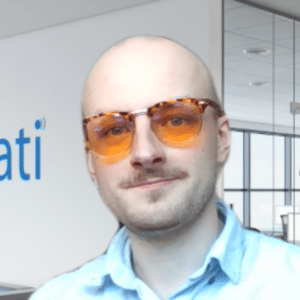A Conversation with Lester Thomas from Vodafone Group
Part 2 of 2

Introduction
We sat down with Lester Thomas, Chief IT Systems Architect at Vodafone Group, and asked him a series of questions about his experiences with, and opinion on the use of AI, Machine Learning and analytics in Telecoms. Click here to read the first part of this interview.
How important are data quality services right now? And how has the maturity journey developed to improve the data point?
As part of our data governance policy, we have policies around things like data standards. It’s very difficult to drive insight and value from data if you have such a plethora of different standards for your data, so we do a lot work on “can we normalise our data into data standards?”, then there’s things like applying a quality metric to that data. In Vodafone, every type of data that we have has an owner, and that owner is responsible for improving the quality of that data – we’ve seen lots of commercial improvements driven by having better quality data.
We do a lot of work around “how do you make sure you’re taking the right level of care with your data?” – the right privacy. You don’t want to do anything that the customers would think “oh hang on, this is something I’m not comfortable with”, so we do a lot of work on anonymisation: The data scientists, effectively they’re working on anonymised customer data, only the person with the right permissions can actually work out who the real customer is. There’s a lot of work going on behind the scenes if you’re going to drive, as part of your data strategy, the right level of standards, quality, and the right policies to apply to data.

“AI and Machine Learning, effectively, is saying you don’t actually need a human to program all these things: you can be driven by data and by a goal“
How do you drive value out of data using analytics and AI?
In new services driven by IoT and 5G, lots of them aren’t connecting humans and smartphones, lots of them are going beyond connectivity. If you put yourselves in the position of an enterprise customer of Vodafone that has some problem they want to address, often you want to meet them further up that value chain.
I’ll give you an example that would be something we do in the insurance space. Insurance is an important vertical – there’s a lot of valuable data to drive, one of the things we do is we support insurance companies selling these services where you have a little black box in your car, particularly for younger drivers – it helps lower their premiums. The service Vodafone sells isn’t connectivity to a box, we don’t even just sell the connectivity and the box to go in the car, because the insurance company actually wants to know: “Is this driver a good driver? Are they driving safely?”. What we do is we sell the whole service, including getting the data from that box, analysing in big data analytics platforms and providing a driver analytic record to the insurance company, because that’s what they want. Imagine if you were working in the insurance space, you don’t want to have to manage millions of devices and all of the complexity that comes with that, so one of Vodafone’s services is saying “we will manage all that for you” – right from the portal where they’re configuring their device, all the way through to saying “here is an analytic record of the driver behaviour”.
What's your experience with, and opinion on using AI and Machine Learning to drive investments?
I mentioned that we were using AI to drive network investment (see part 1), so we invest billions of Euros every year in the networks, historically we looked long term: In the past, you might have talked about what coverage you have in a particular area, because data is something where the quality can vary so much. We do all of our network planning and next week investments based on optimising it, not for coverage, but actually for the customer impact: We identify where there were actually customers that use all the data, what are the existing challenges those customers have? Then you’re optimising your network investment – the billions you’re spending on network impact investment – to have the biggest impact for your customers.
How do you think the future of AI will pan out over the next 10 years? Do you think it will continue to take up more space?
We’ve faced a challenge over the last few decades about how there’s not enough programmers in the world to do all the programming that you could do to have the positive impact on the world that intelligence automation can have. AI and Machine Learning, effectively, is saying you don’t actually need a human to program all these things: you can be driven by data and by a goal, you’re automating how you’re actually building the algorithm. The algorithm is built in these neural networks by training, based on a dataset, rather than having humans actually create those programs – I see this being applied to many more spaces.
You look at your operational IT systems, every time there is an optimisation, a complex decision driving structure from data, any time there’s those sorts of challenges you should be asking yourself “could I use an analytics or Machine Learning type approach to solve those problems?”. We’ve moved from static, on-premise solutions to cloud, to cloud native – in which things are much more dynamic. Most cloud native solutions today might be driven by policies where you’re saying “I’m going to drive lots more automation”, so things are happening automatically behind the scenes, scaling up, scaling down, those sorts of things based on the policy – that’s almost like a roadmap. When you choose AI, you’re not doing it based on a policy: you’re doing it based on a goal, you say “my goal is optimising the cost and the customer experience of a particular solution”. By constantly analysing the data, learning, and having this Machine Learning behaviour, you can move from having lots of people working out what is the right policy, to stating a goal and having this Machine Learning constantly optimise, changing over time to give you the optimum solution for whatever your goal is.
Our partner Bruhati have a successful track record in helping organisations through their Architecture Maturity Journey and enabling them to become fully digital. For more information and a FREE consultation please visit www.bruhati.com or contact sales@bruhati.com
Feel free to comment and subscribe to be notified when a new article is published.


